After circling the ubosot within the Wat Suthat temple complex, I moved to the back part of the compound where there are facilities for accommodating monks. This area resembles a small town with streets and houses on both sides.
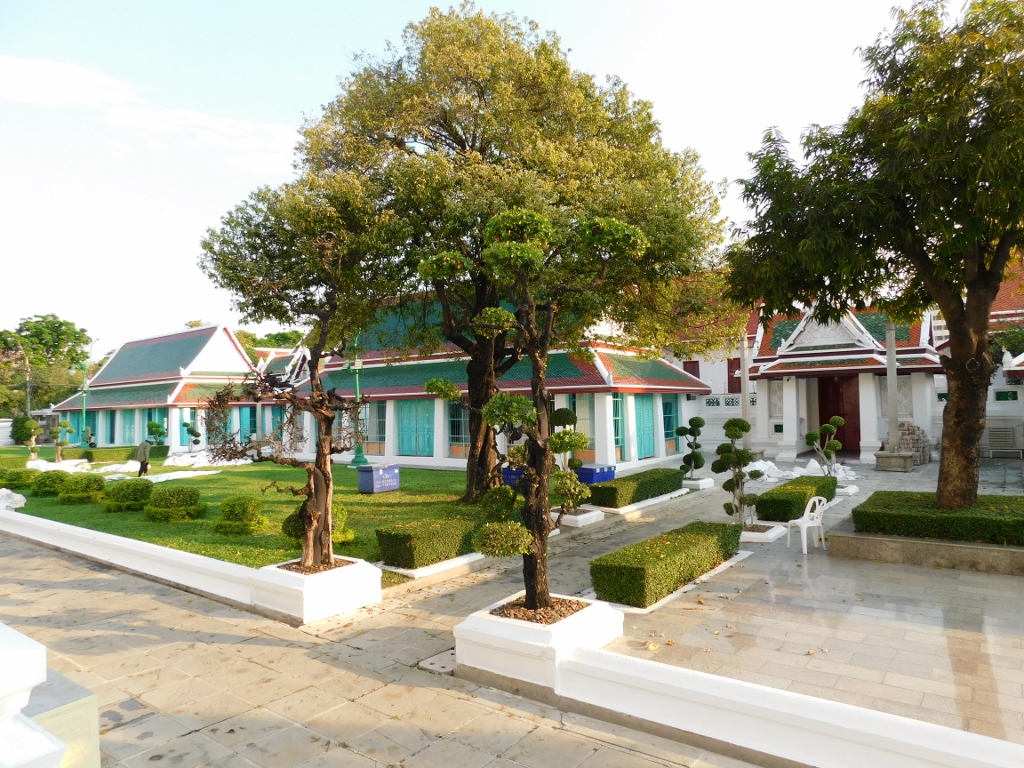 Wat Suthat temple, path leading towards the residential part of the temple complex
Wat Suthat temple, path leading towards the residential part of the temple complex
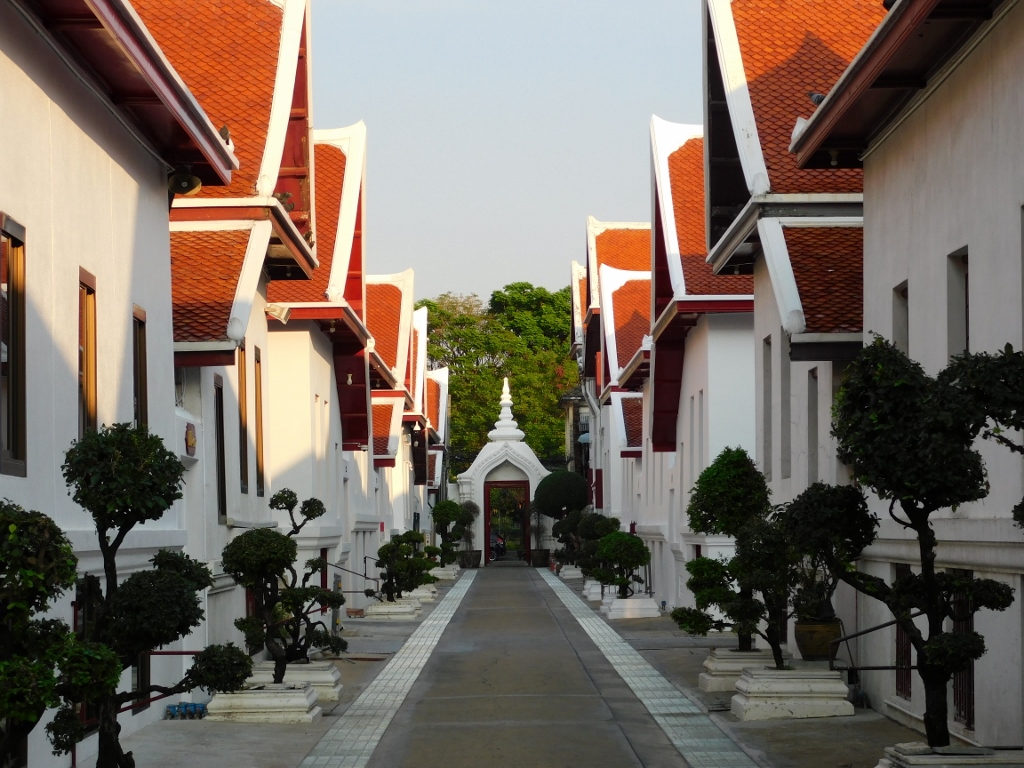 Wat Suthat temple, residential part of the temple complex
Wat Suthat temple, residential part of the temple complex
I took a short stroll in that area and then I started heading back towards the part of the temple where the ubosot is located.
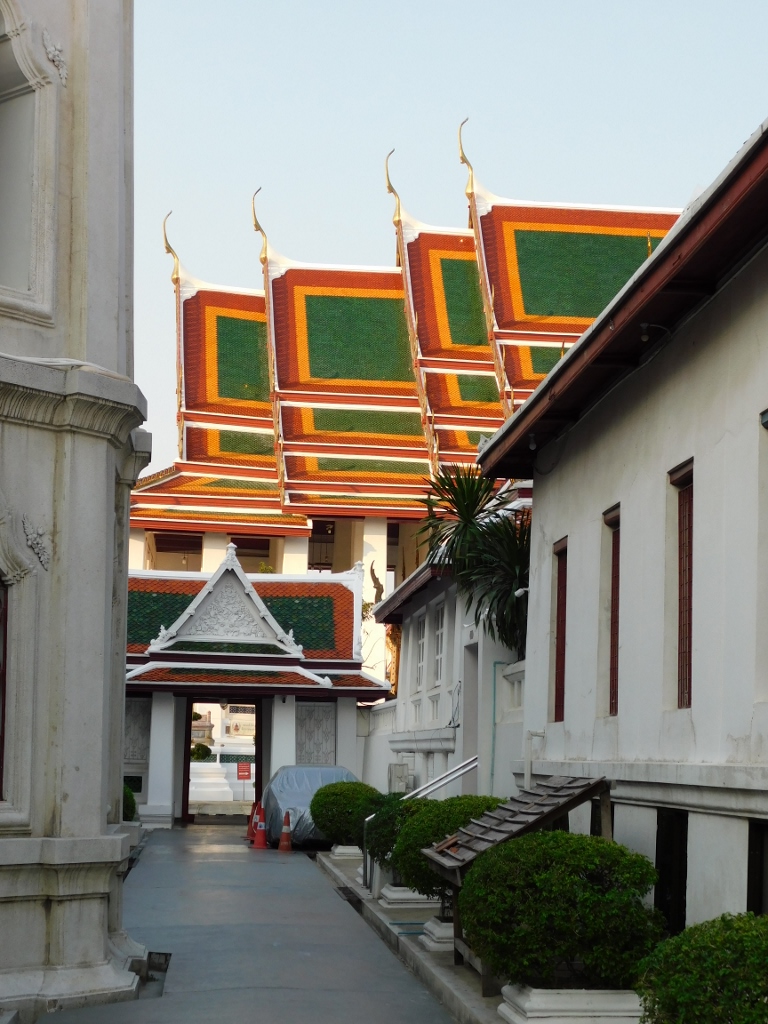 Wat Suthat temple, path in the residential area and the impressive roof of the ubosot
Wat Suthat temple, path in the residential area and the impressive roof of the ubosot
Now I simply walked around the ubosot and continued towards the front inner courtyard where the vihara is located because I needed to explore it in detail. Its roof, illuminated by the late afternoon sun, was impressive.
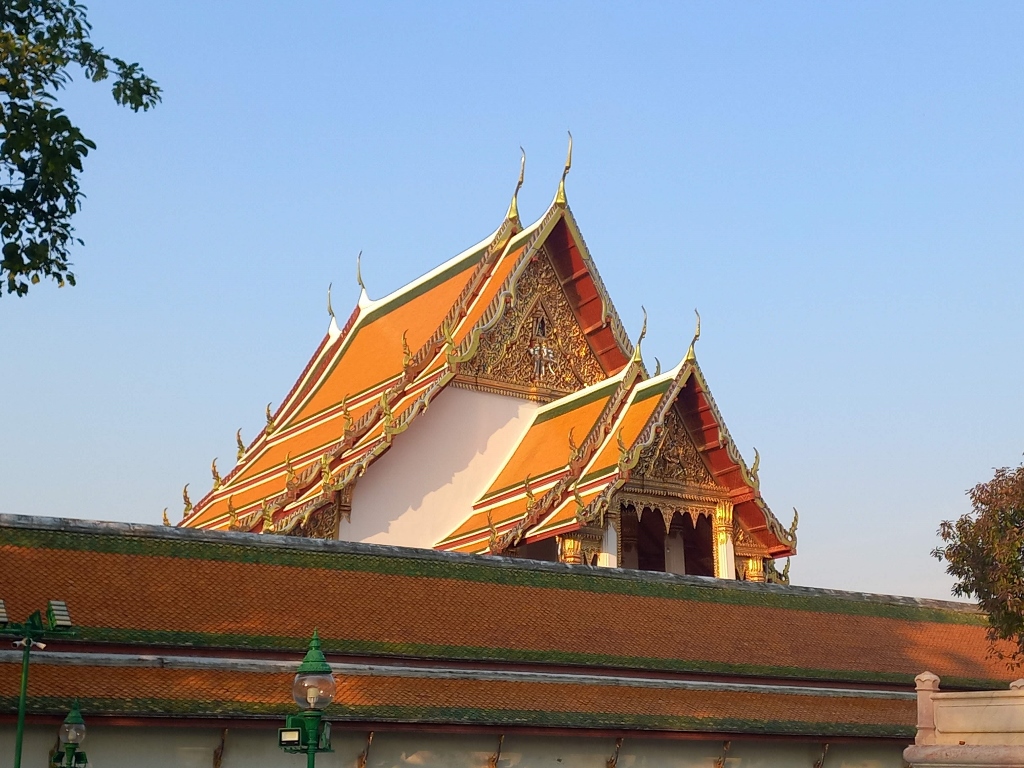 Wat Suthat temple, a detail
Wat Suthat temple, a detail
I decided to enter the inner courtyard around the vihara from the side in order to change the route a bit, so I followed the path that goes around the outside of the gallery surrounding the square courtyard. Here, I passed by a fountain that clearly shows Chinese influence.
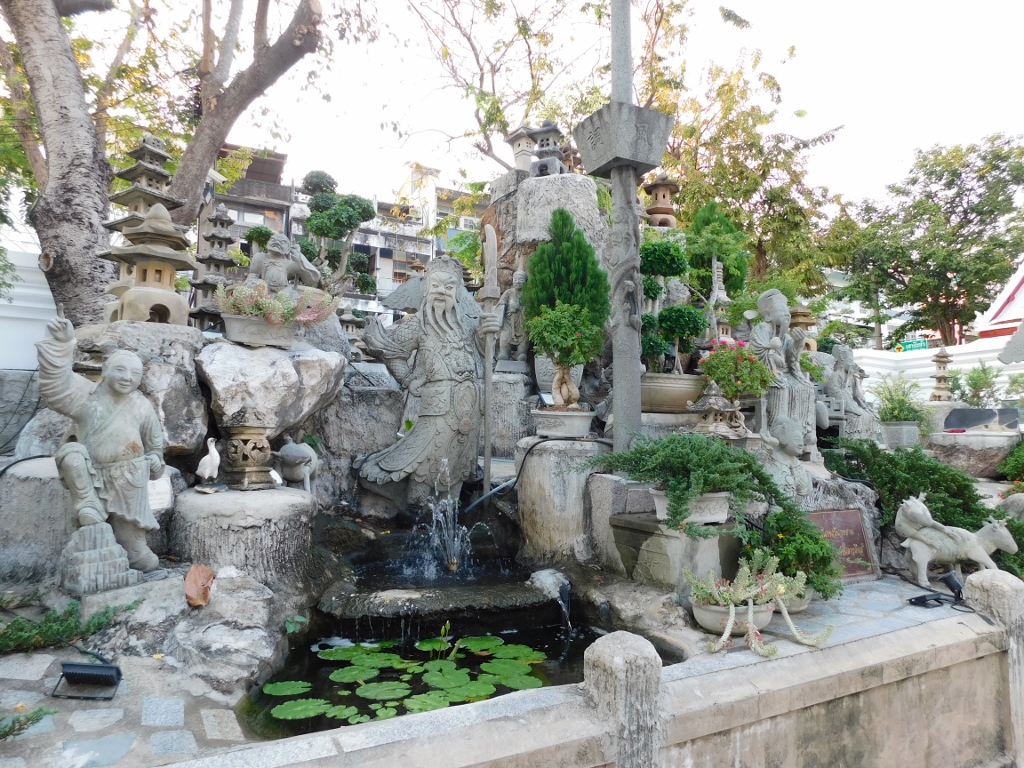 Wat Suthat temple, a detail
Wat Suthat temple, a detail
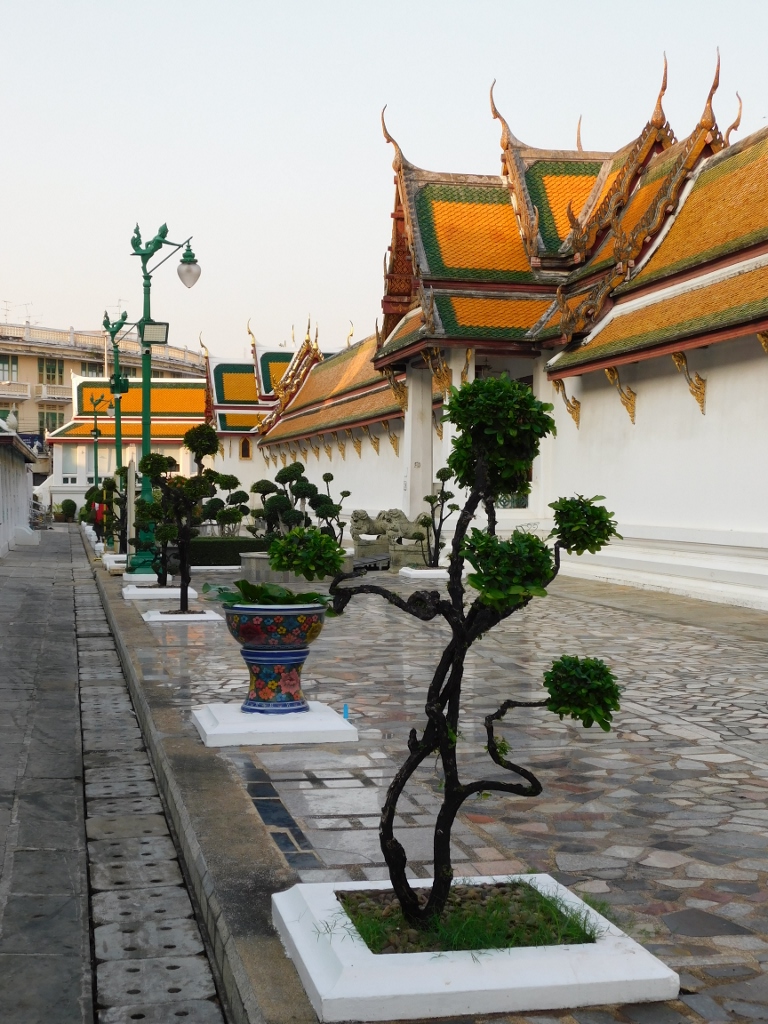 Wat Suthat temple, access to a side gate leading to the inner courtyard
Wat Suthat temple, access to a side gate leading to the inner courtyard
Both the gallery and the vihara have roofs that are crafted in perfect harmony, and everything looked especially beautiful bathed in the afternoon sunlight.
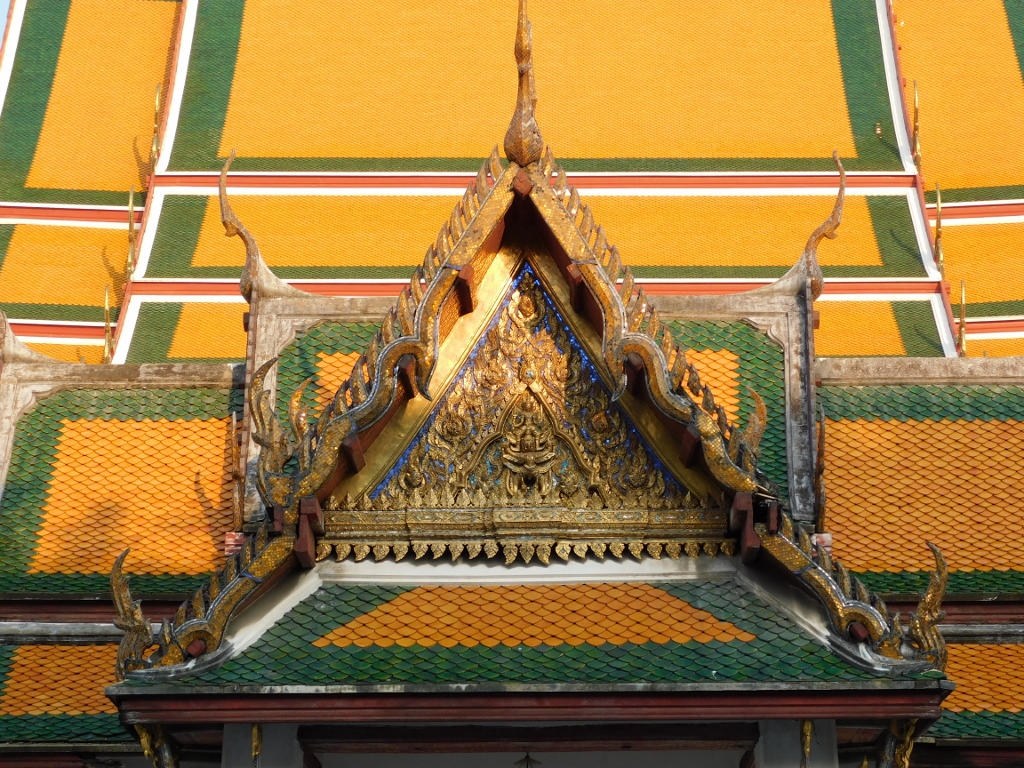 Wat Suthat temple, a detail
Wat Suthat temple, a detail
Once you pass the side gate, you enter the gallery along which 156 statues of Buddha are lined up, as I mentioned in the previous part of the story, but these statues are certainly impressive enough that I took photos of them again.
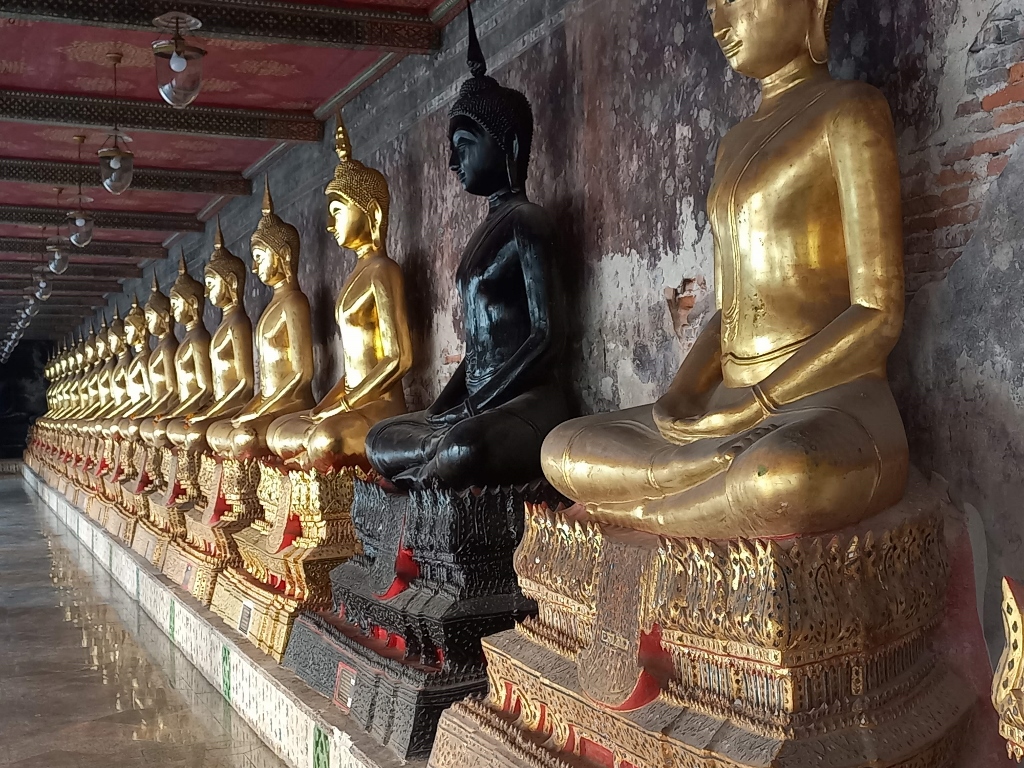 Wat Suthat temple, a detail
Wat Suthat temple, a detail
And then I stepped back into the inner courtyard at the centre of which is the vihara of the Wat Suthat Temple.
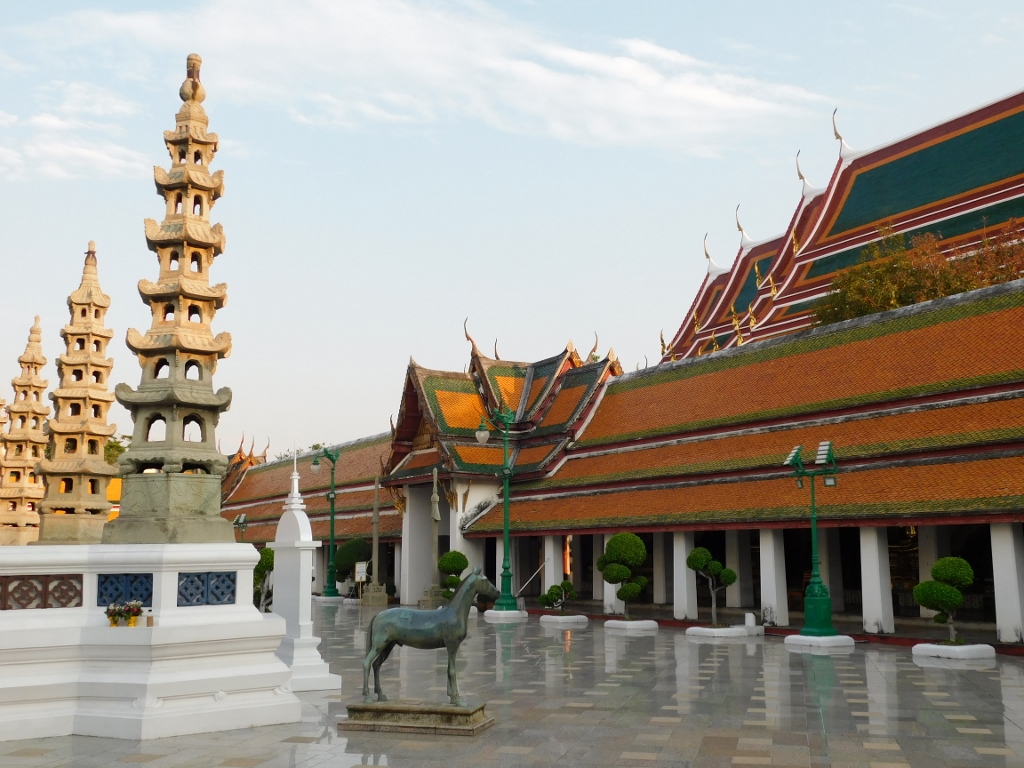 Wat Suthat temple, a detail
Wat Suthat temple, a detail
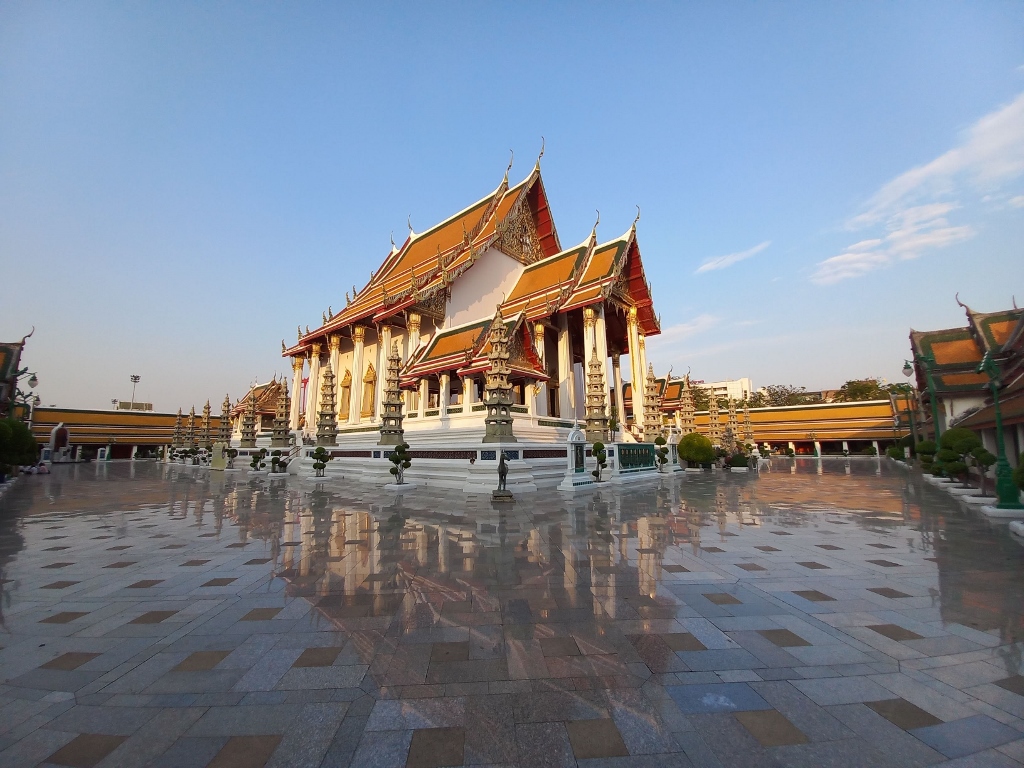 Wat Suthat temple, the vihara
Wat Suthat temple, the vihara
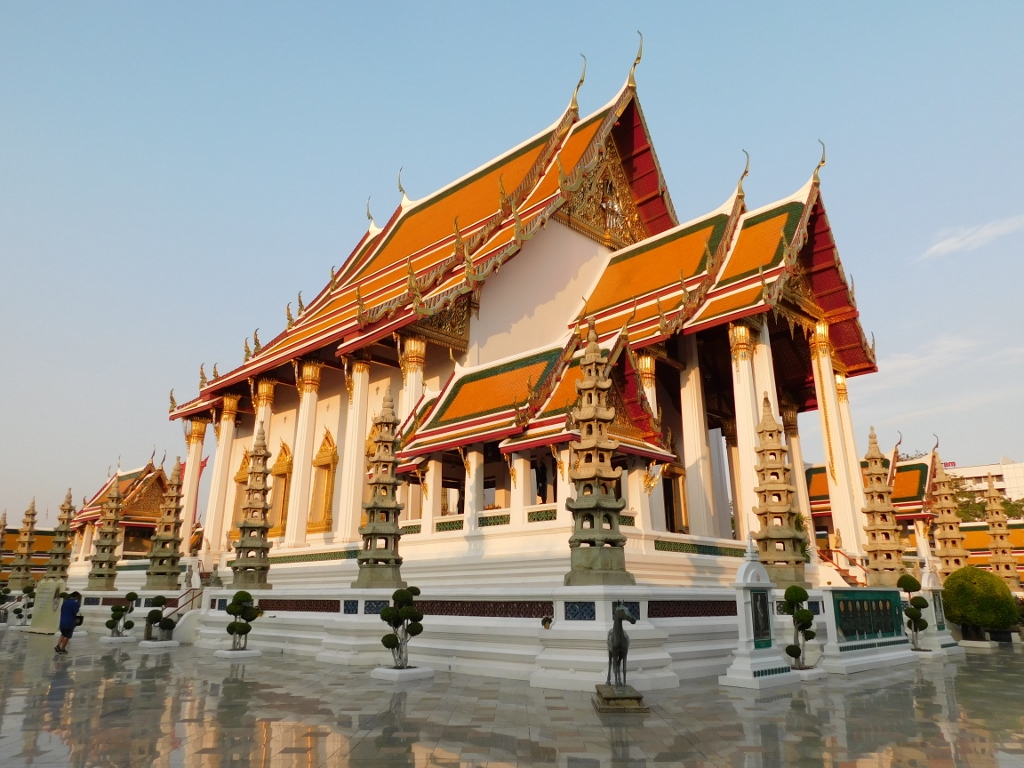 Wat Suthat temple, the vihara
Wat Suthat temple, the vihara
The Wat Suthat temple was built during the time when the capital of the kingdom was called Rattanakosin and it was formed on a practically artificial island of the same name – Rattanakosin Island. I have mentioned earlier that this “island” was created when a canal was dug in the form of an arch on the eastern side of a larger piece of land, while on its western side, also in a loop, flows the Chao Phraya River. To add to the intrigue, at least in terms of the names, the city, which later became known as Bangkok, was the capital of the kingdom also called Rattanakosin that officially existed from 1782 to 1932.
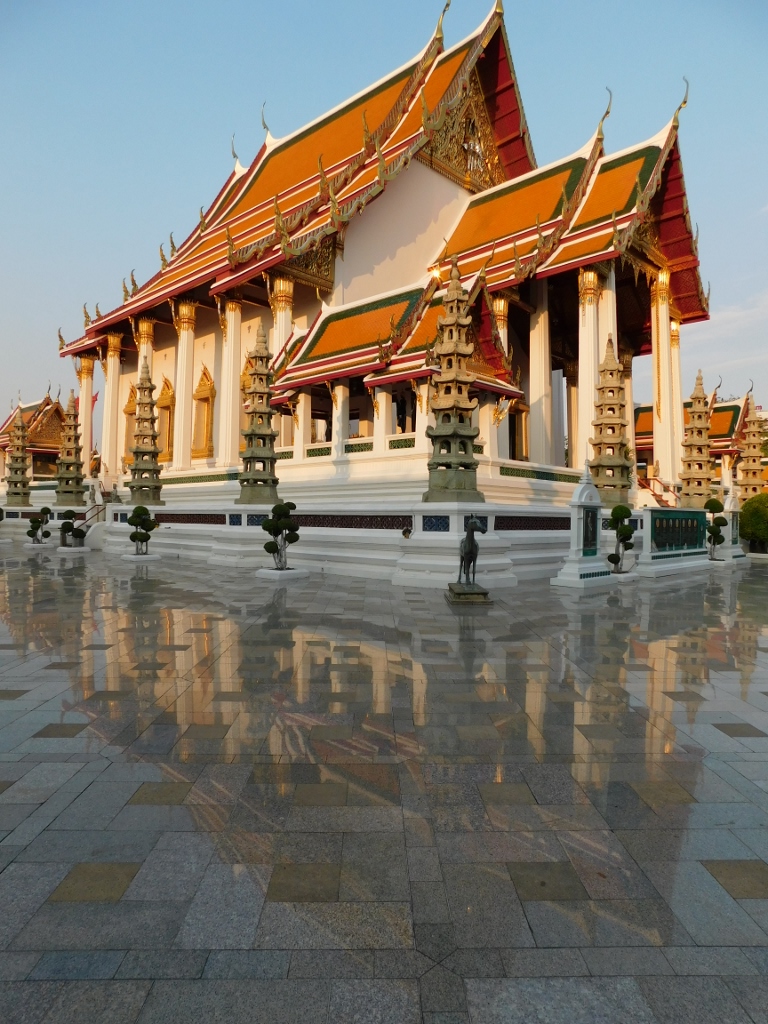 Wat Suthat temple, the vihara
Wat Suthat temple, the vihara
Since the temple was erected in the centre of the capital city, it was designed to be the most magnificent temple in the kingdom. Given that everything related to the design of the Wat Suthat had a spiritual dimension, the temple was conceived as a symbolic representation of Mount Meru or Sumeru, a sacred mountain located at the centre of the physical, metaphysical and spiritual universes. According to the Thai Buddhist cosmology, this mountain is the abode of God Indra, the deity associated with the sky, thunder, lightning, rain, rivers and war.
The wealth of the decorations visible on the exterior of the vihara, as well as throughout the temple, is truly impressive. I found it particularly interesting to see the three-headed elephant Airavata or Erawan (in Thai) on the highest pediment.
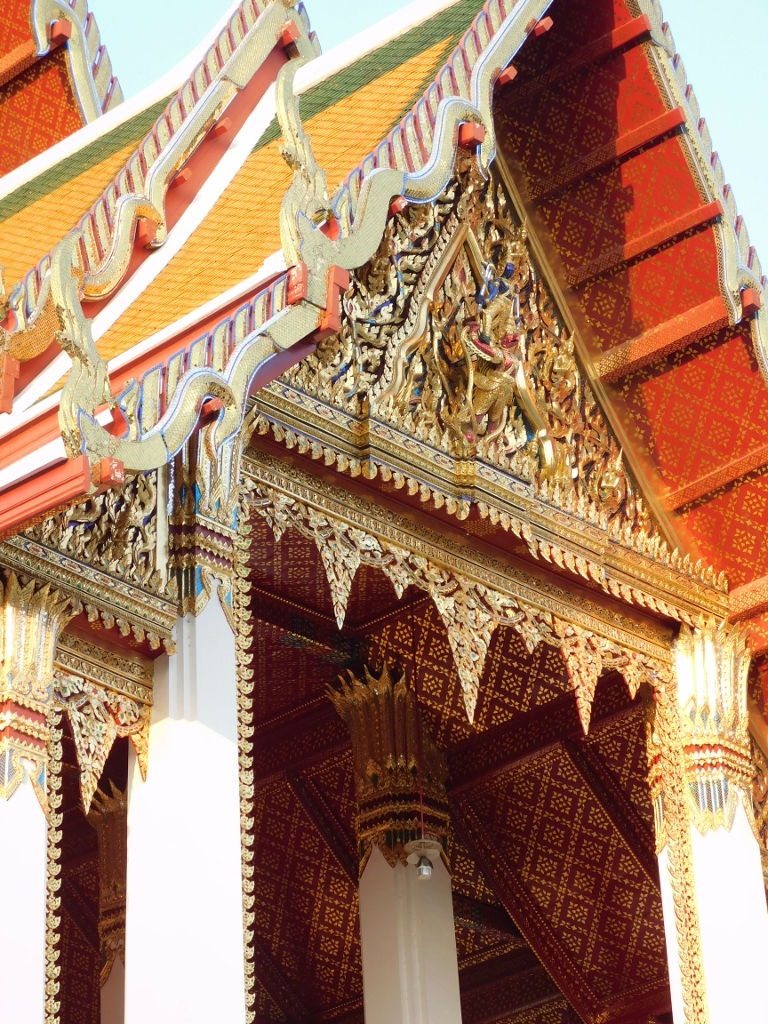 Wat Suthat temple, the vihara, a detail
Wat Suthat temple, the vihara, a detail
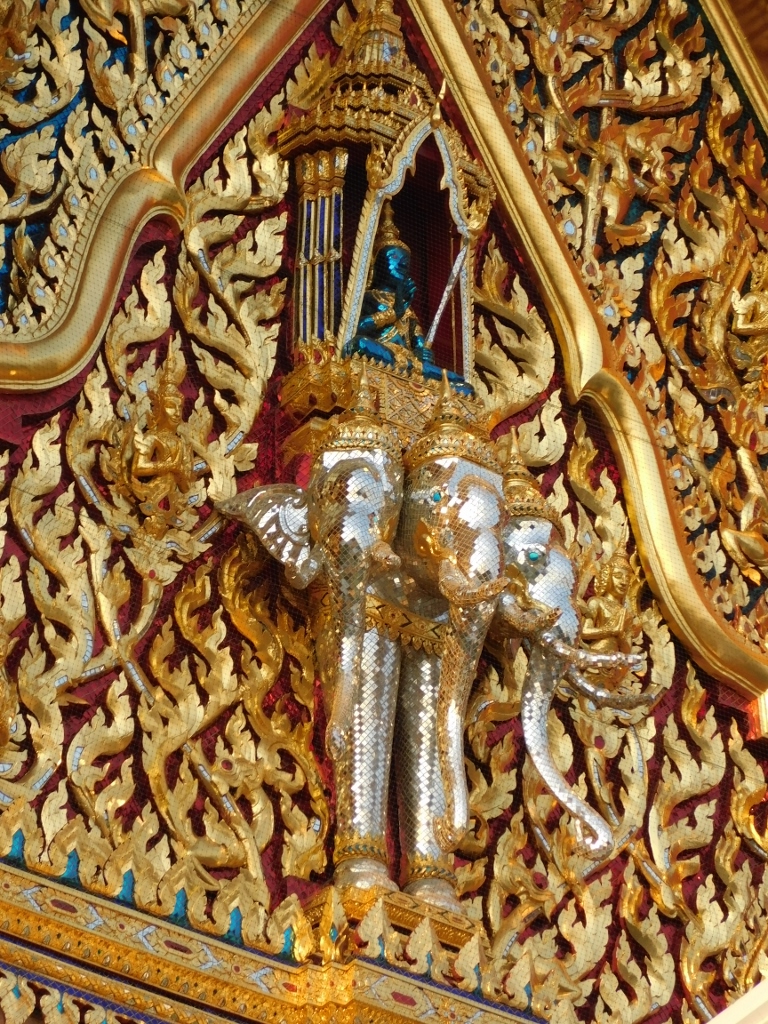 Wat Suthat temple, the three-headed elephant Airavata or Erawan in Thai carrying God Indra
Wat Suthat temple, the three-headed elephant Airavata or Erawan in Thai carrying God Indra
Namely, Airavata or Erawan is a mythological elephant that served as the mount for God Indra. This elephant has become a symbol of Bangkok precisely on account of its association with God Indra because even in the ceremonial name of the city (which, incidentally, holds a Guinness World Record as the longest place name, consisting of 168 letters), it is mentioned that Bangkok is a city built by the order of God Indra.
I have now walked through the inner courtyard to approach the main entrance to the vihara. Everywhere around me, there were wonderful and charming sights and details.
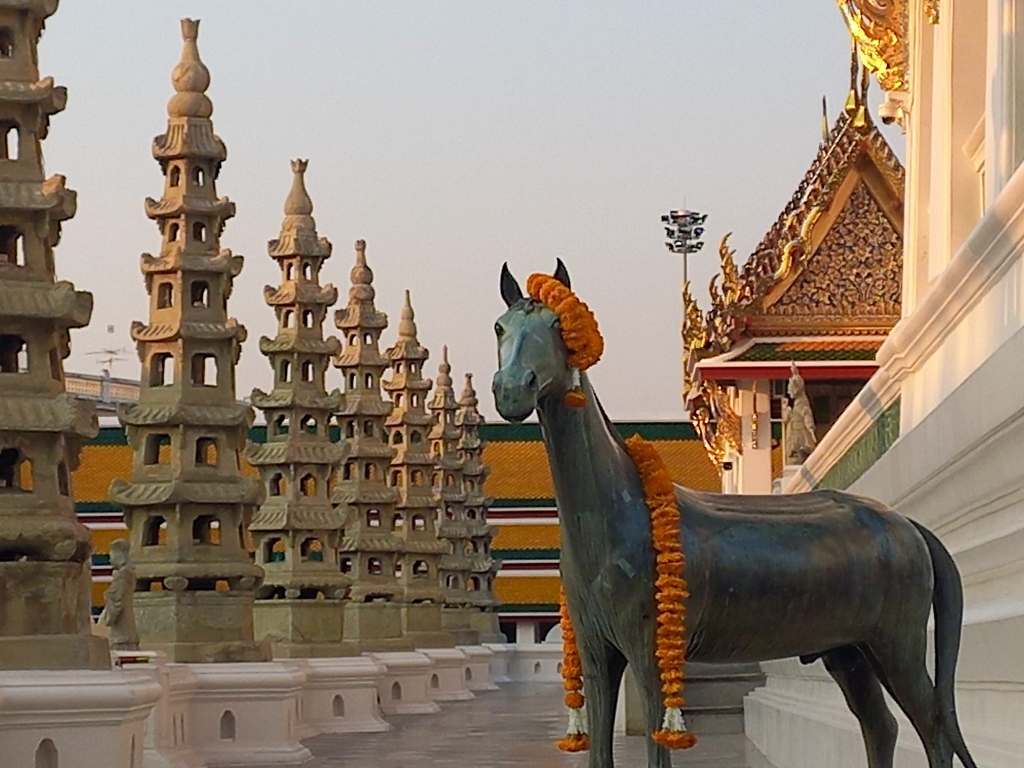 Wat Suthat temple, a detail
Wat Suthat temple, a detail
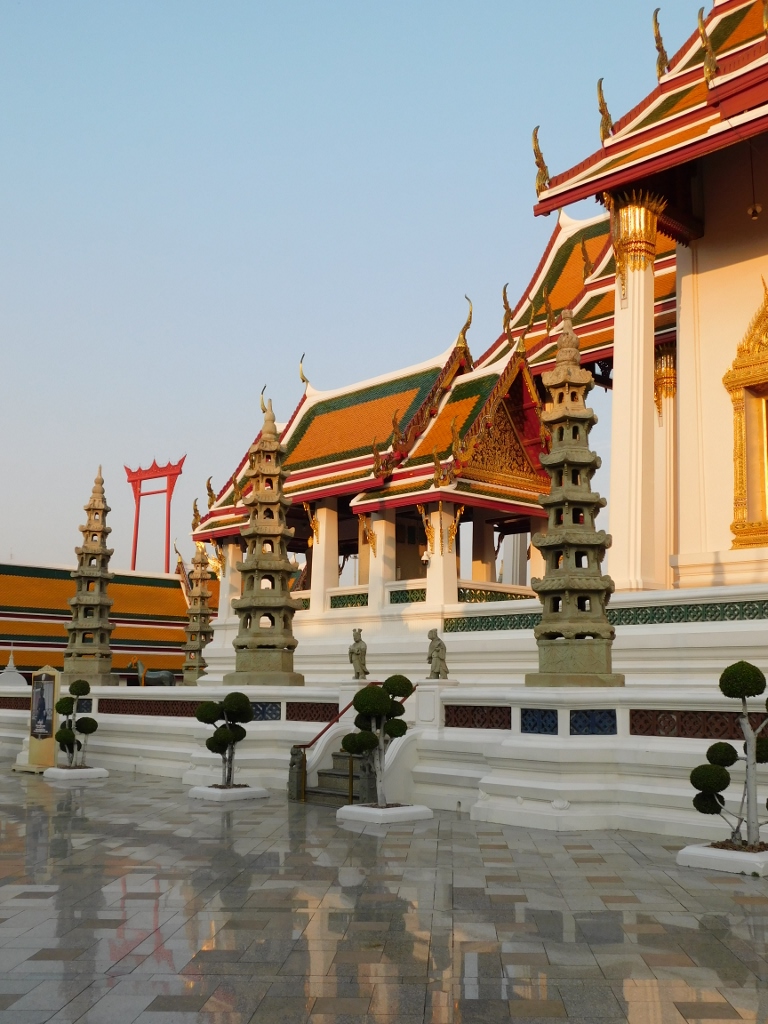 Wat Suthat temple, a detail
Wat Suthat temple, a detail
Even though it was permitted to walk around the courtyard with the shoes on, everything seemed sparkling clean, so I think I wouldn’t have minded walking barefoot either.
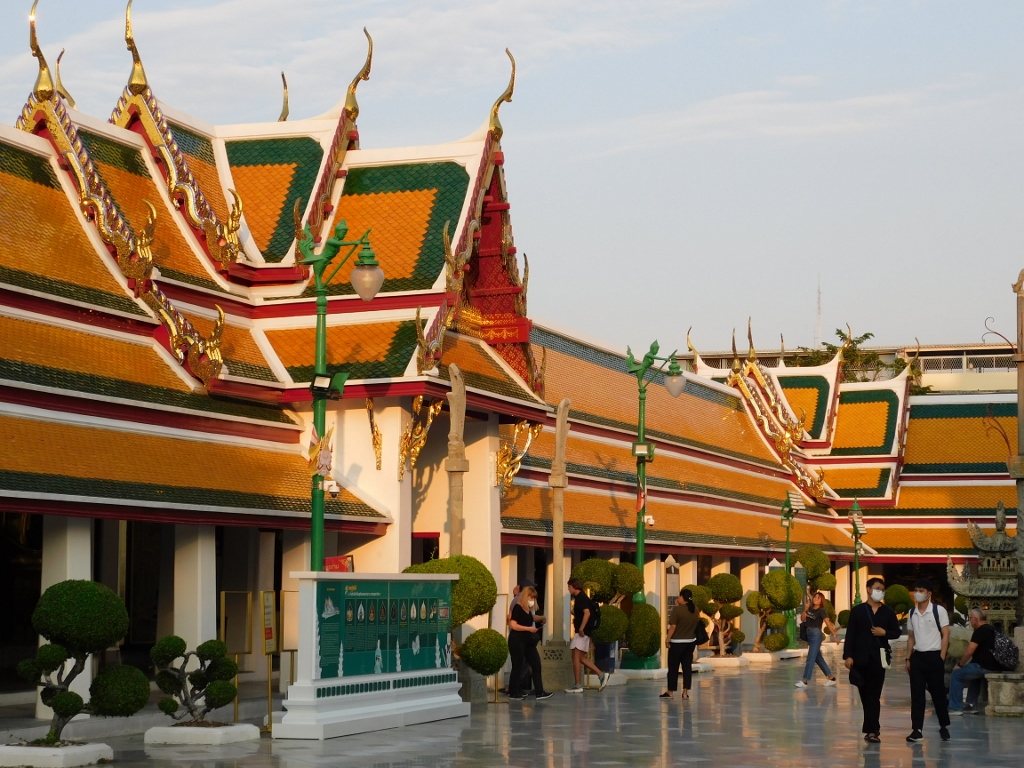 Wat Suthat temple, a detail
Wat Suthat temple, a detail
And then, finally, I started with my visit to the vihara. I took off my shoes and left them where it was designated and then I first approached the shrine set in front of the open main doors through which the main Buddha statue could be seen. It was clear that it was one impressive statue.
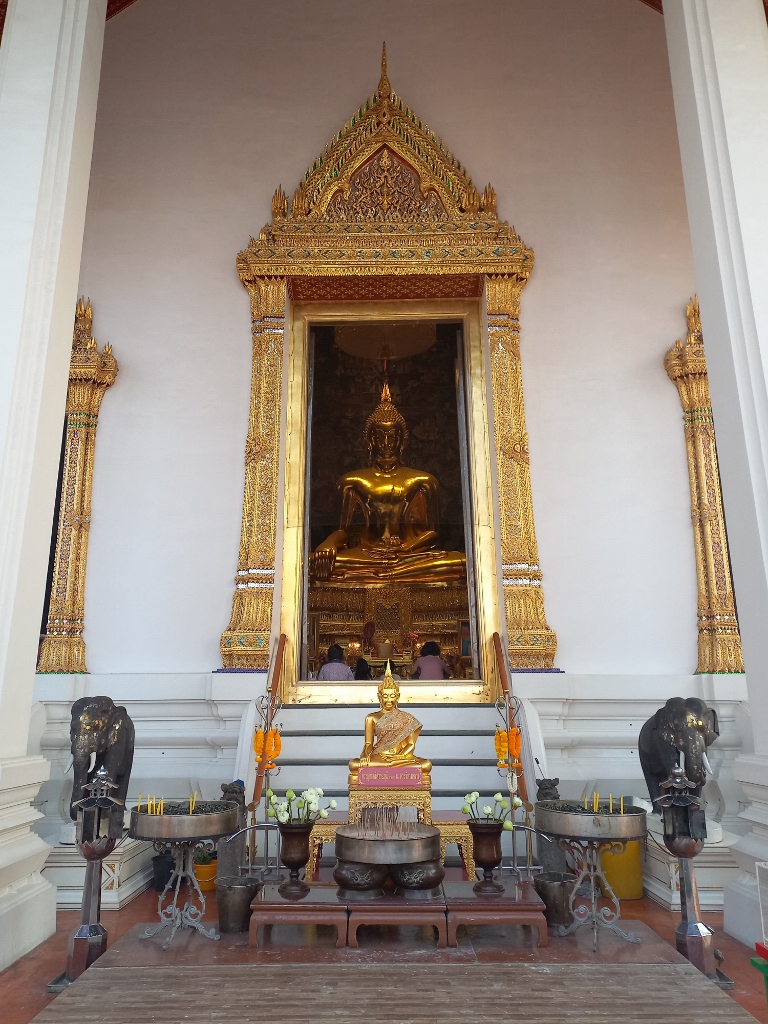 Wat Suthat temple, the vihara, a detail
Wat Suthat temple, the vihara, a detail
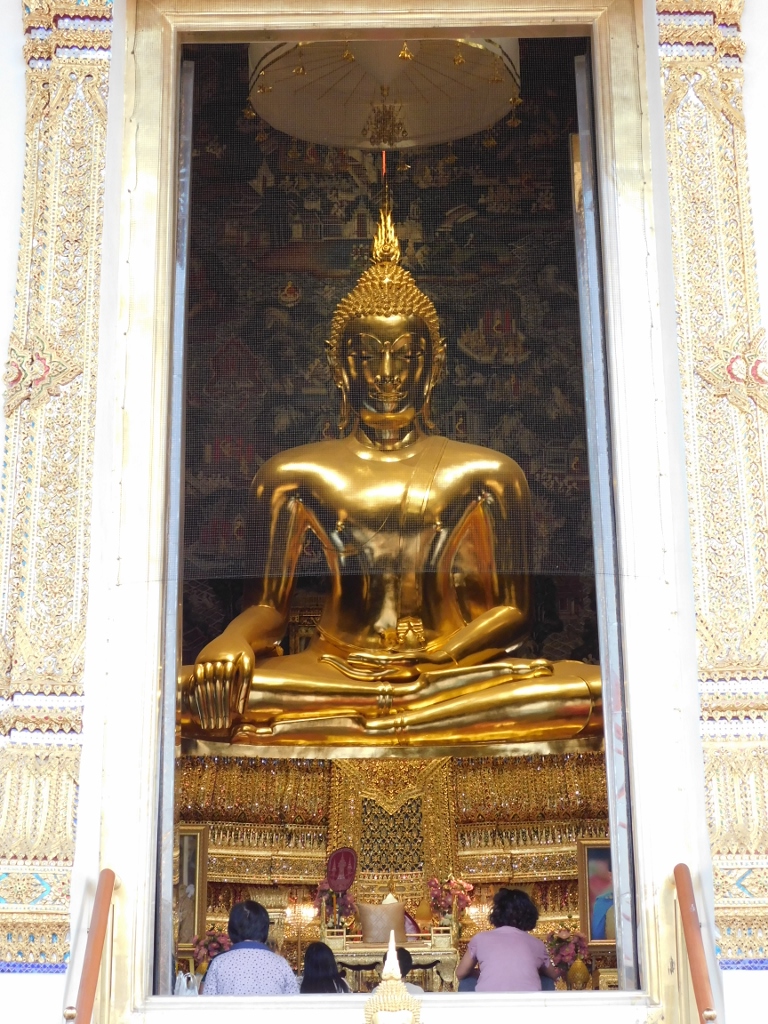 Wat Suthat temple, the vihara, a detail
Wat Suthat temple, the vihara, a detail
When I entered, I was taken aback by the powerful impression caused primarily by the opulence of the decorations, including wall paintings, although the space was also exceptionally large. Additionally, there were more worshippers engaged in prayer inside the vihara at this time. I’ve mentioned earlier that it is considered a sign of great disrespect if one’s feet or, more specifically, the soles are pointed towards the Buddha (this is not an issue if you’re standing or walking inside the temple). However, if you sit, it can be in the lotus position, since in that case the shins essentially point towards the statue, or you can kneel or place your legs to the side (first kneeling and then sitting beside your feet turned backward). Respecting these rules is crucial when visiting Buddhist temples in Thailand and praying inside. Those who do not wish to adhere to these guidelines should simply avoid entering the temples.
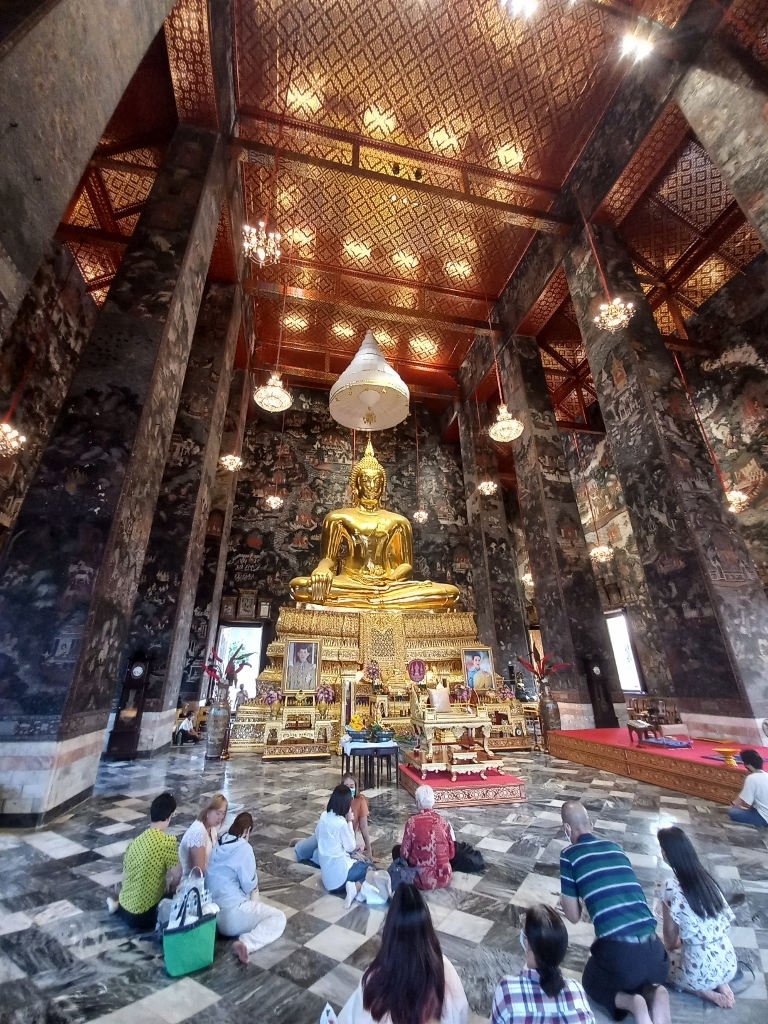 Wat Suthat temple, the vihara, a detail
Wat Suthat temple, the vihara, a detail
As for the Buddha, the statue is called Phra Si Sakayamuni and it stands at 8 meters tall. It is the largest bronze Buddha statue from the Sukhothai period in Thailand, cast in the 14th century. However, it is evident that the statue is either gilded or painted with gold colour (I couldn’t find specific information). Although I believe this detail is not crucial, I talk about it because there is a constant mention that it is a bronze statue and it does not have the colour of bronze. In any case, the ashes of King Rama VIII (b/r 1925/1936-1946) are enshrined at the base of the statue.
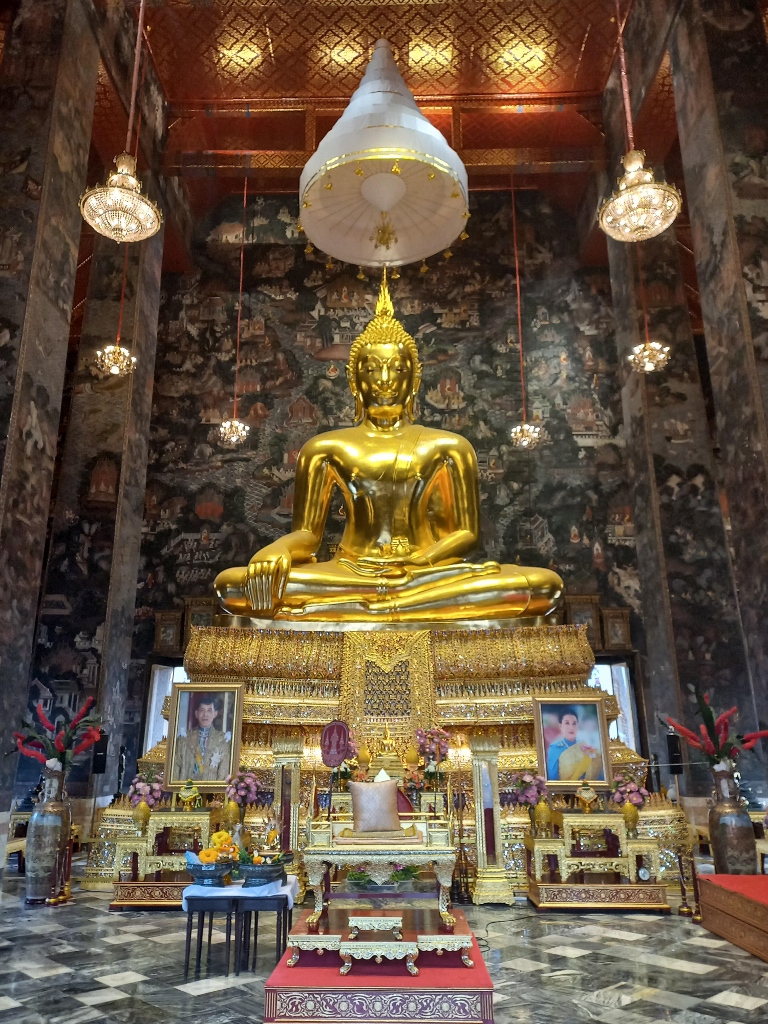 Wat Suthat temple, the vihara, a detail
Wat Suthat temple, the vihara, a detail
Besides the famous statue, the vihara also features exceptionally beautiful 19th-century murals depicting stories about the Buddha, specifically his 28 incarnations. Incidentally, around the vihara, there are decorative cast Chinese pagodas (visible in the previous photos), precisely 28 of them, symbolising the 28 Buddhas who were born on Earth.
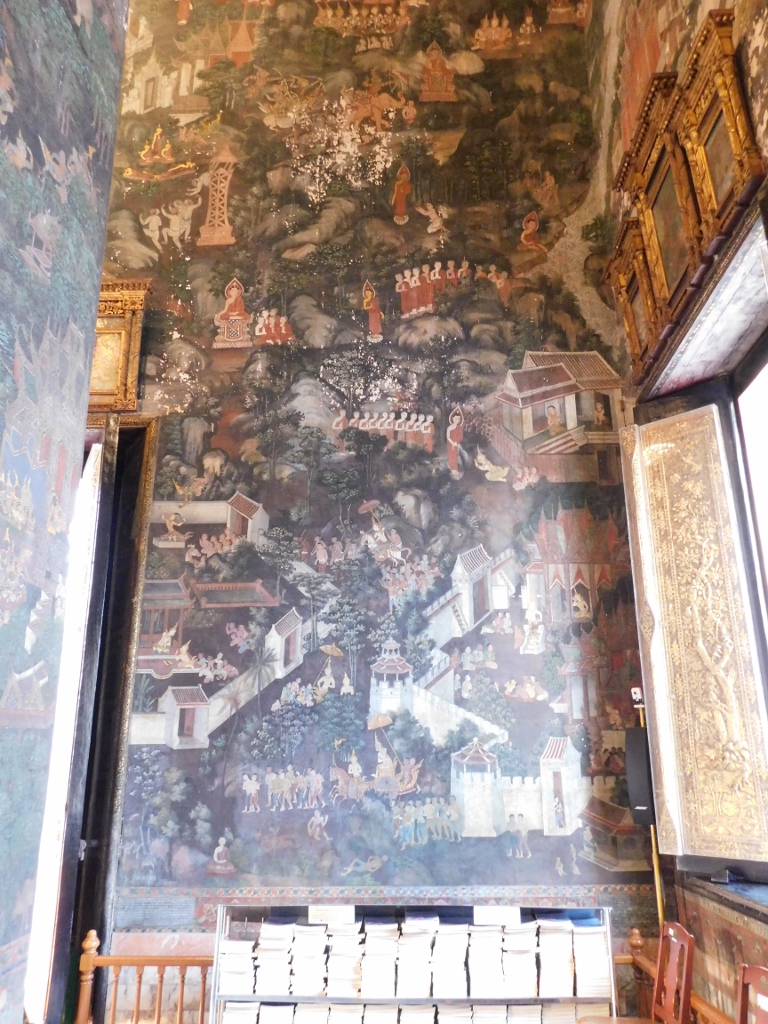 Wat Suthat temple, the vihara, a detail
Wat Suthat temple, the vihara, a detail
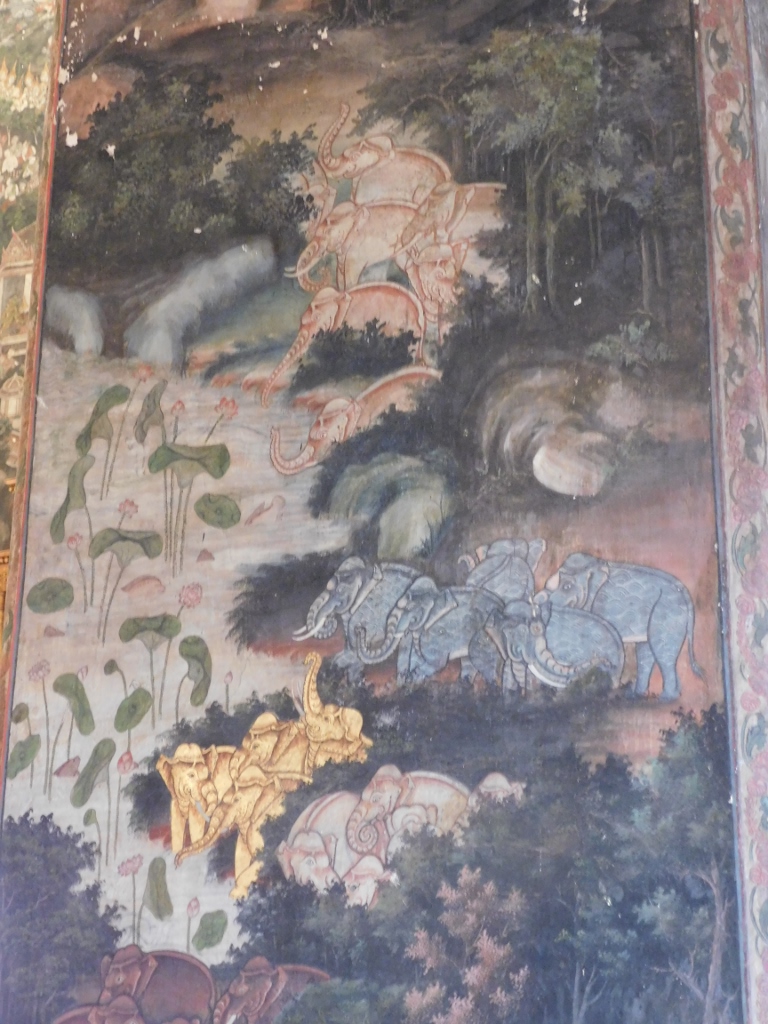 Wat Suthat temple, the vihara, a detail
Wat Suthat temple, the vihara, a detail
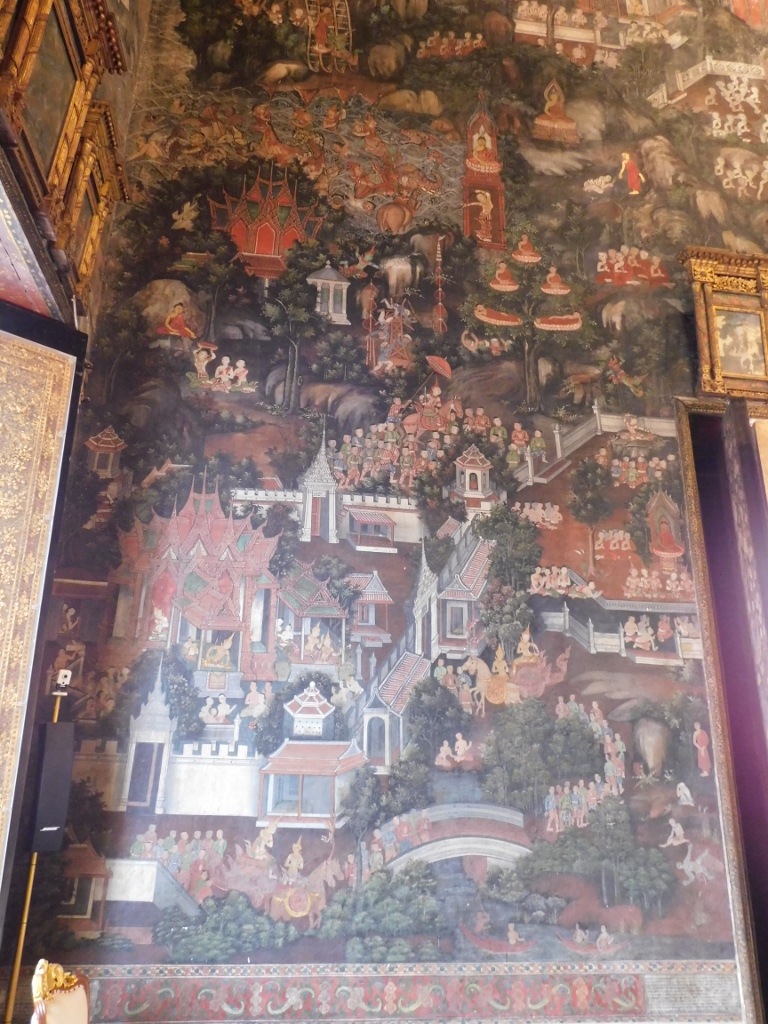 Wat Suthat temple, the vihara, a detail
Wat Suthat temple, the vihara, a detail
There is also an interesting wall painting that turned out a bit blurry in my photos, but it depicts a Preta – a tall, thin and perpetually hungry spirit from Buddhist (as well as Hindu and Chinese) legends. There’s even a story that one Preta can be seen at night within the Wat Suthat itself. Since I explored the temple during the day, I only saw the Preta on the painted wall.
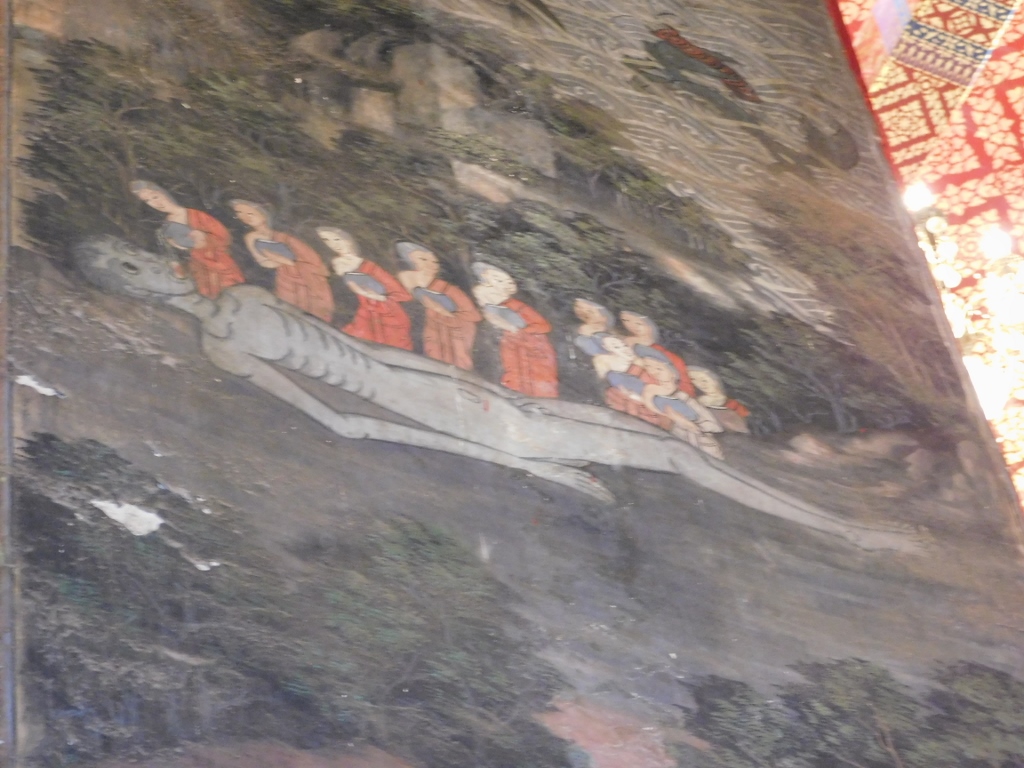 Wat Suthat temple, the vihara, a detail
Wat Suthat temple, the vihara, a detail
Then I walked around the Buddha statue to see how everything was organised. As it can be seen from the next few photos, the Buddha statue is placed on a very ornate pedestal and there is also a smaller shrine here.
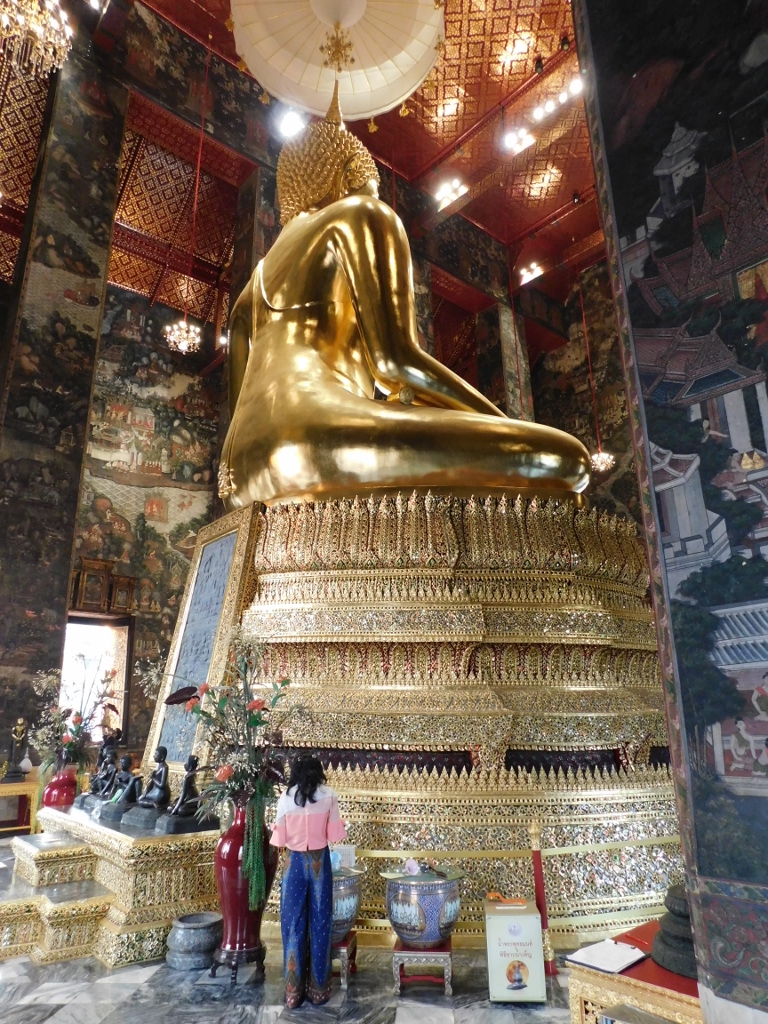 Wat Suthat temple, the vihara, a detail
Wat Suthat temple, the vihara, a detail
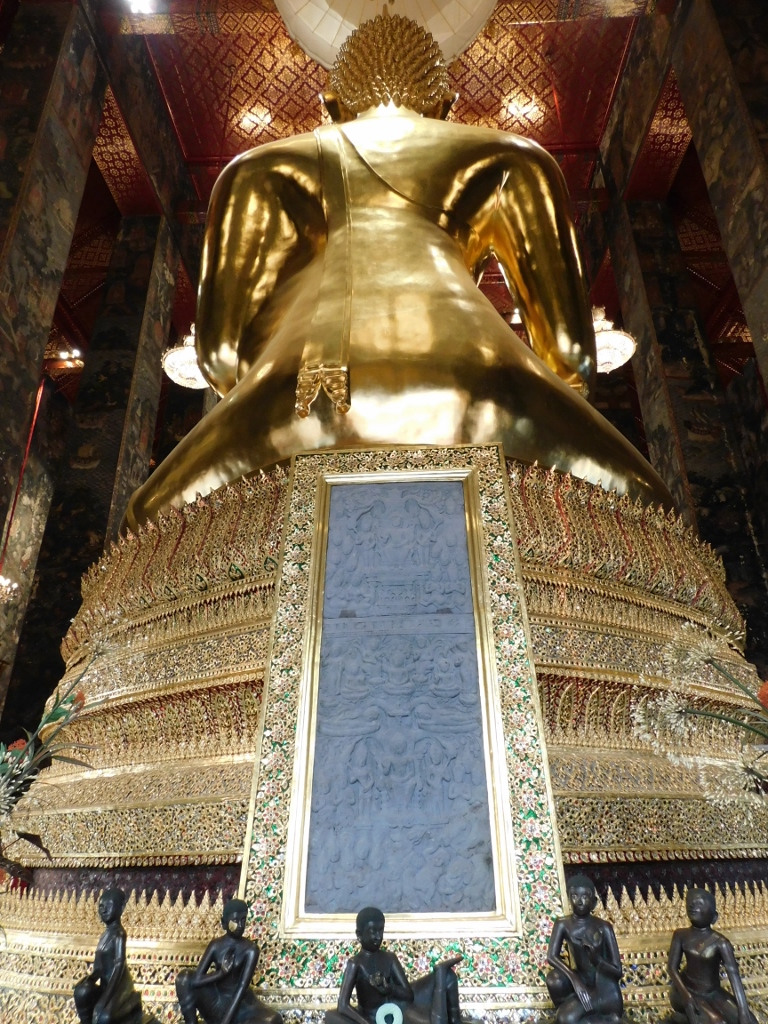 Wat Suthat temple, the vihara, a detail
Wat Suthat temple, the vihara, a detail
Behind the Buddha statue are the back doors of the vihara and I peeked through them in order to see and capture the view towards the ubosot. Additionally, one of those 28 Chinese pagodas is visible in the centre.
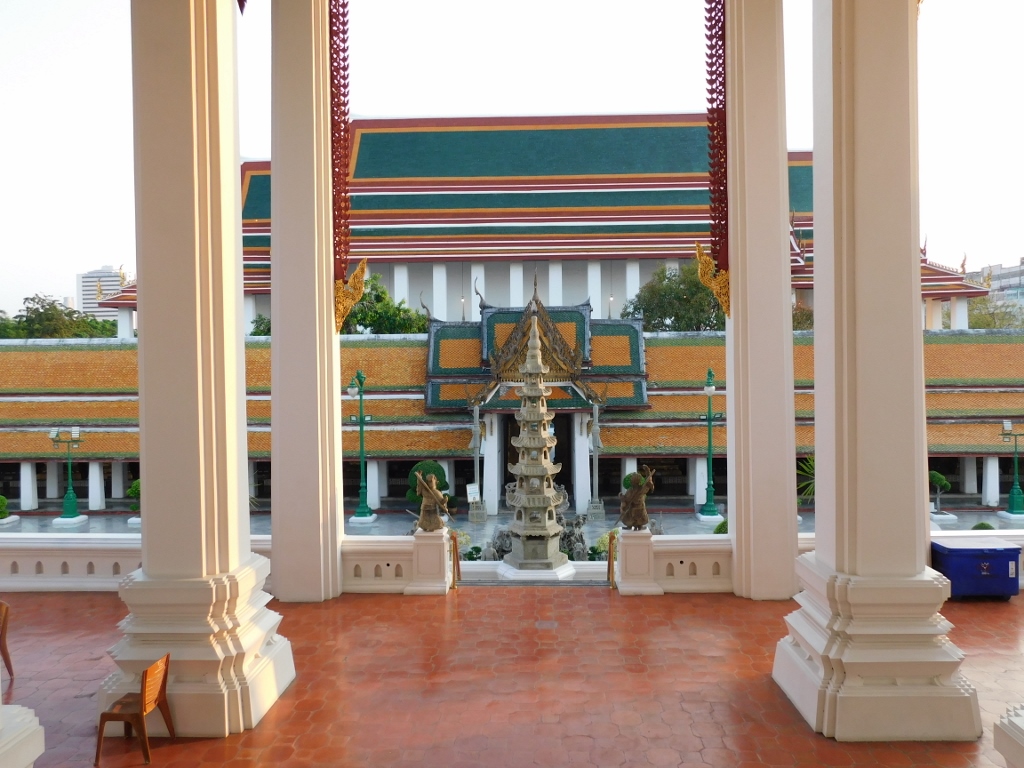 Wat Suthat temple, the vihara, a detail
Wat Suthat temple, the vihara, a detail
After I had finished exploring the vihara, I returned to the shrine near the front entrance where some people were praying. I briefly captured this scene and didn’t disturb them further. I waited for them to finish their prayer and then I took another photo of this shrine’s details.
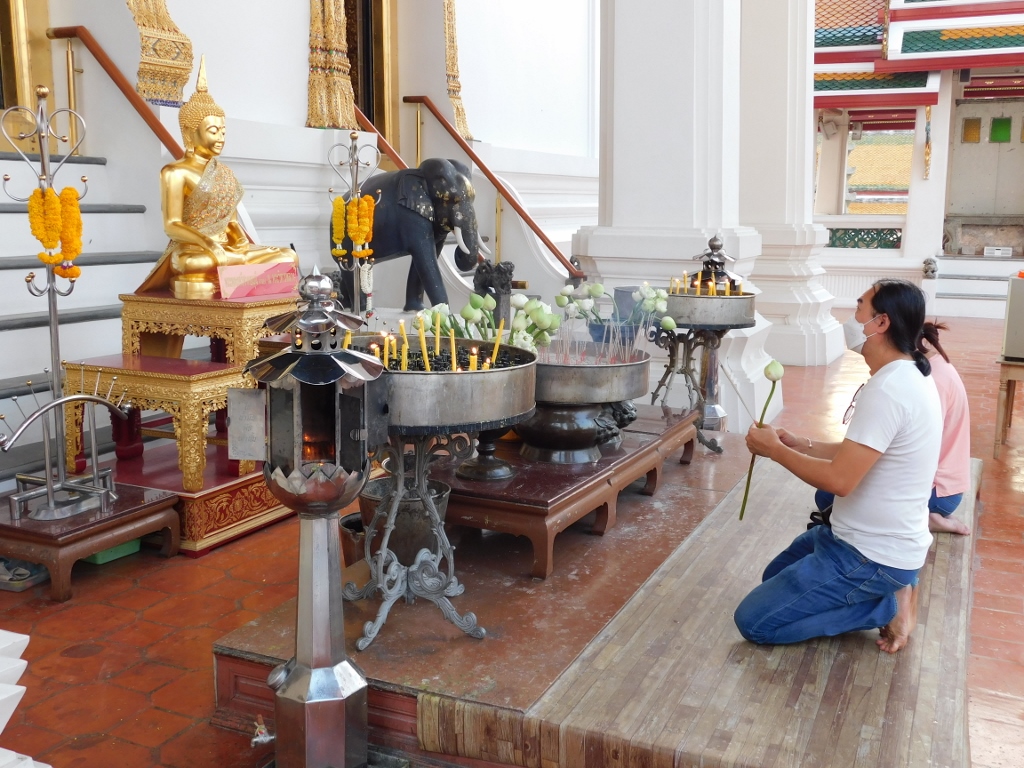 Wat Suthat temple, the vihara, a detail
Wat Suthat temple, the vihara, a detail
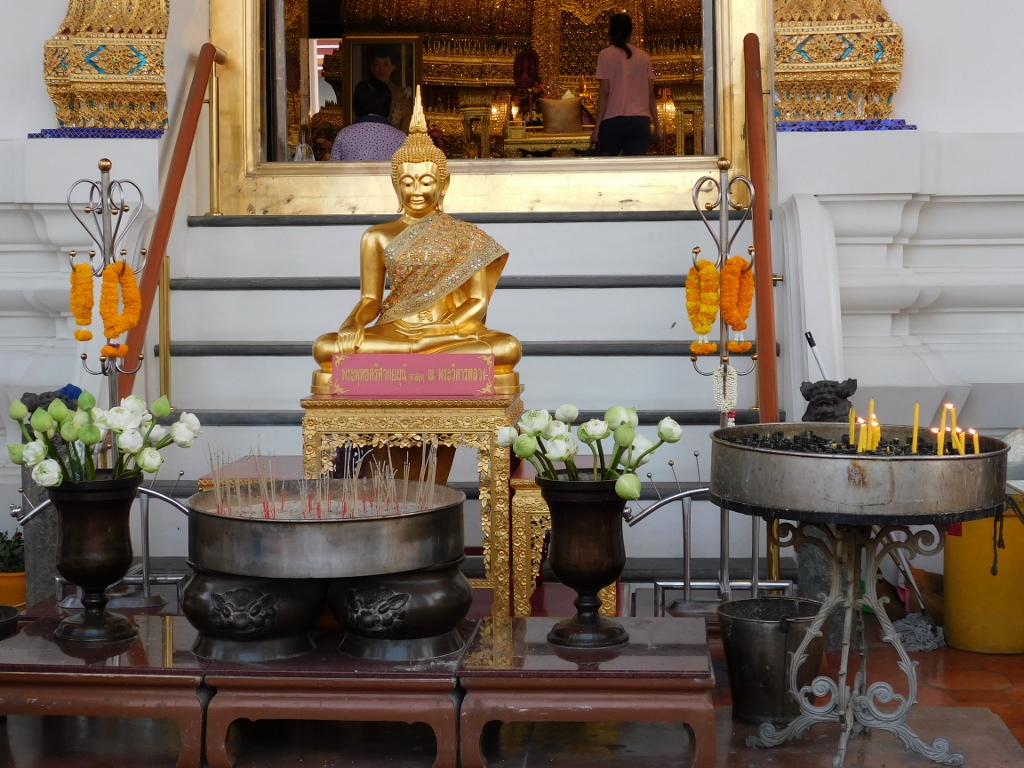 Wat Suthat temple, the vihara, a detail
Wat Suthat temple, the vihara, a detail
With this I ended my visit to the Wat Suthat temple that I found extremely appealing. Now, I was ready to go somewhere for dinner.
On my way back to the hotel, I conveniently stopped by a branch of a well-known restaurant in Bangkok with Michelin recognition. Just to clarify, this isn’t a Michelin-starred restaurant (with one, two or three stars); instead, it’s a different kind of recognition – Bib Gourmand – which means the place offers high-quality local food at affordable prices. The restaurant had a canteen-like atmosphere, but that didn’t bother me at all – the food was excellent and I suddenly found myself very hungry, so I immediately ordered two dishes.
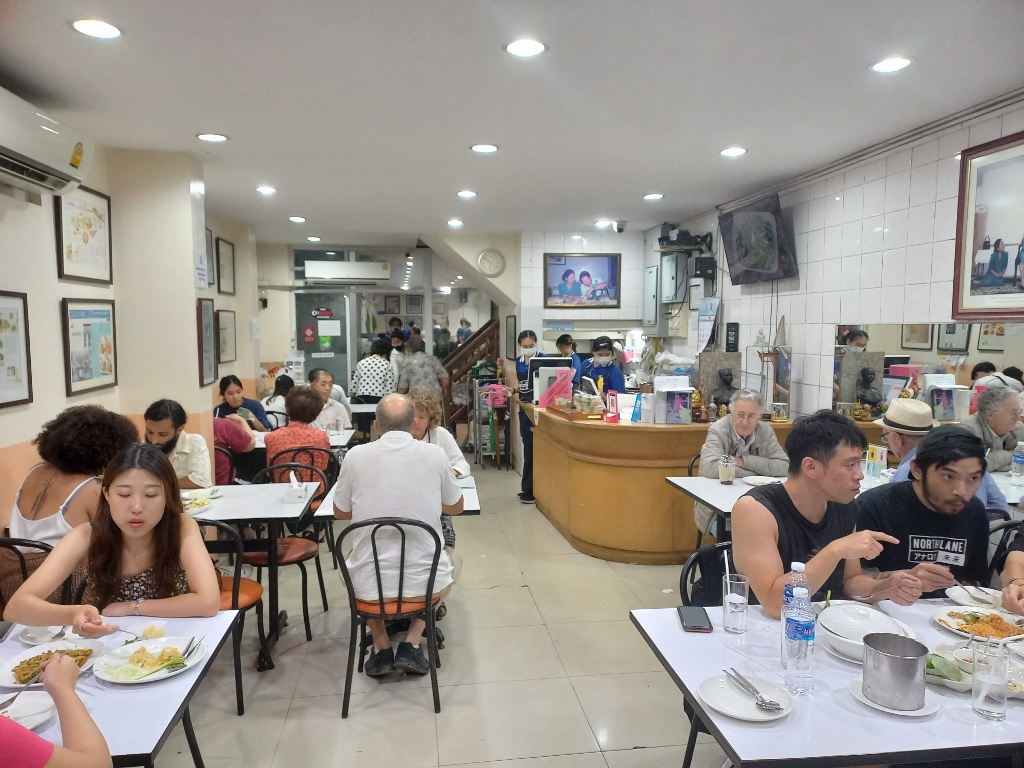 Popular, and yet simple restaurant in Bangkok
Popular, and yet simple restaurant in Bangkok
I devoured the first dish right away, but I ate the second one for a long time and ended up not finishing it entirely. The reason was simple: the dish was incredibly hot (in terms of spice). I can handle hot, but not to this extent. On the other hand, this was my first time trying the famous Thai dish – Green Curry.
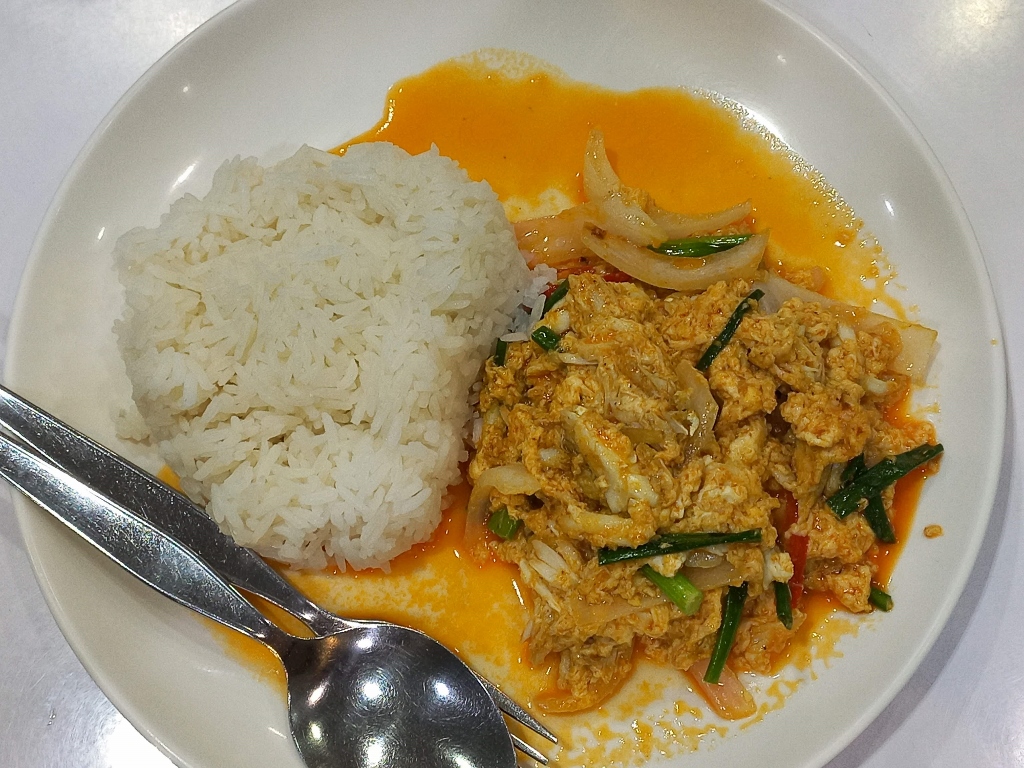 Dinner in Bangkok when I’m very hungry, part 1
Dinner in Bangkok when I’m very hungry, part 1
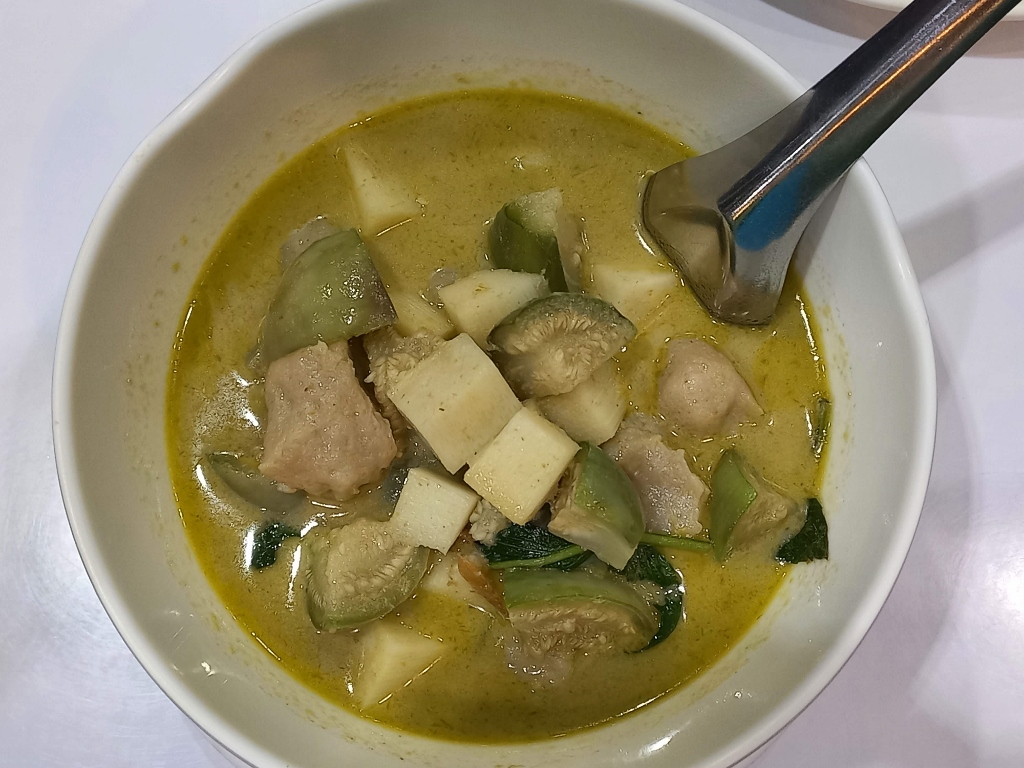 Dinner in Bangkok when I’m very hungry, part 2
Dinner in Bangkok when I’m very hungry, part 2
Although the Green Curry is always hot, later I tried milder versions that were more to my liking and I even decided to make it at home. However, it’s crucial to get a jar of green curry paste, as that is certainly an easier option than making the paste from scratch at home, or you can use a packet of powdered spice mix. In any case, here’s my version of green curry:
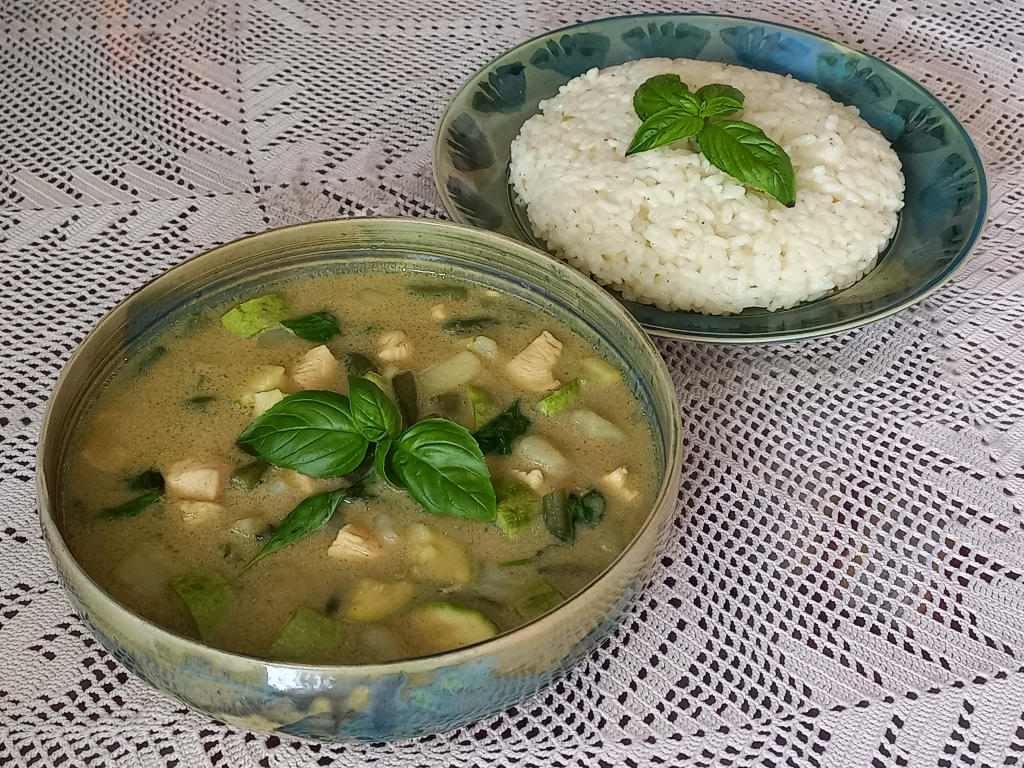 Green Curry “à la moi” served in dishes that I have also made
Green Curry “à la moi” served in dishes that I have also made
GREEN CURRY
- 1 larger potato, diced
- 100 g of green beans
- 1 smaller courgette cut into bigger dices
- 200 g of chicken breasts, diced
- 400 ml of coconut milk
- 1 tbsp of green curry paste (or a small bag of dried green curry spice mixture)
- spices: 1 clove of garlic, 1 tsp of sugar, 2 tsp of fish sauce, a little lime zest
- 50 g basil or coriander leaves
Put the potato cubes to cook in salted water, then after 6-7 minutes add the green beans and cook for another 3-4 minutes. The potatoes should be almost cooked. Then, drain and set aside.
In a pot (or a wok), sauté the chopped garlic in a little oil, then add the green curry paste and sauté a bit more to release its aroma. Then pour in the coconut milk. Once it starts to simmer, add the fish sauce and sugar, and then the chicken. Cook for about 10 minutes on low heat until the chicken is almost cooked. Then add the potatoes, green beans and the chopped zucchini and cook for a few more minutes until the potatoes and chicken are fully cooked.
Season with the lime zest and before serving, add chopped cilantro or basil leaves. Serve with boiled rice.
And as for the green curry I had at the beginning of my stay in Bangkok, it was so hot that I worried if I might have stomach issues. However, nothing happened and I went to bed quite early that evening because I was very tired. I’ve mentioned earlier that according to the pedometer on my mobile phone I walked over 20 km on foot that day. It didn’t seem that long and the accuracy of these apps is questionable, but the point is that I did walk a lot and felt tired. My plan was to get a good night’s sleep to be ready for new explorations and encounters the following day.
That night I slept wonderfully and for a long time, and I think I really needed that. I felt much better the next morning and I decided to ease the pressure on myself and my sightseeing plans. To start with, I stopped by a café near the hotel and had a cup of coffee.
Then I hopped into a tuk-tuk and headed for the Grand Palace. The woman at the reception in my hotel suggested taking a taxi since it’s cheaper than a tuk-tuk (taxis use a meter, while tuk-tuk drivers try to overcharge tourists), but a taxi driver refused to take me because the Grand Palace was too close for his liking. Under normal circumstances, I might have walked there, but on this day, I decided to spare my legs a bit, plus that part of the route had become a bit monotonous since I had already passed along it a few times on my way to the National Museum and back.
The tuk-tuk ride was, as always, interesting and it inspired me enough to make a short video of it.
The Grand Palace is a complex founded in 1782 and it includes not only the royal residence and throne halls, but also several other buildings used by the government, as well as the famous Temple of the Emerald Buddha. All in all, it’s quite a large area that could be explored for a whole day. I didn’t have that much time, so I spent a few hours there and it was a wonderful experience.
Now, as an introduction to the story of the visit to the Grand Palace, let me briefly touch upon a part of the Thai history. In the period from 1767 to 1782, there was the Thonburi Kingdom in Southeast Asia, established by Taksin the Great after the fall of the Ayutthaya Kingdom. The capital of the Thonburi Kingdom was the city of Thonburi, situated on the western bank of the Chao Phraya River, which is now a part of Bangkok. However, in 1782, King Taksin was overthrown by Phra Phutthayotfa Chulalok, a high military commander who, on that occasion, established a new dynasty, the Chakri, which is still in power today. He became King Rama I. By the way, all the kings of the Chakri dynasty are often referred to as Rama (from I to X, the name of the king leading Thailand at the time of my visit in 2023). The reason for this is that Rama is the name of a Hindu god, an avatar of Vishnu, which holds great significance in South Asia. On the other hand, Thai names are often long and challenging for foreigners to pronounce, so using Rama simplifies any reference of this topic.
Therefore, when Rama I came to power, he moved the capital to the eastern bank of the Chao Phraya River, naming it Rattanakosin. The kingdom also adopted the same name – the Rattanakosin Kingdom – lasting from 1782 to 1932, until the Siamese revolution.
Following the king’s decree, the construction of a new palace began on the eastern bank of the Chao Phraya River. It was intended to serve as the royal residence and a location for various administrative buildings. Over time, various temples were also erected and today it has become a vast and impressive tourist destination that includes the Grand Palace and the Wat Phra Kaew temple.
 Access to the Grand Palace complex from the direction of the grassy square Sanam Luang
Access to the Grand Palace complex from the direction of the grassy square Sanam Luang
In order to explore this complex, it is necessary to adhere to strict rules. Firstly, it’s highly important to be dressed modestly. While wearing a short-sleeved shirt was acceptable, my 3/4-length Bermuda shorts were not long enough. Luckily, I had a sarong with me, so I wrapped it around myself, converting it into a long skirt. Colour coordination, in my case, became a secondary concern and besides, in Thailand, people wear all sorts of colour and pattern combinations, so no one raised any objections.